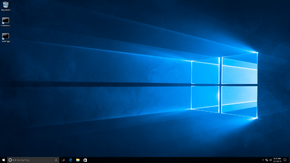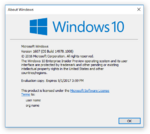The development branch which this build belongs to, which focuses on the ARM64 Cobalt PC bring-up effort, is not to be confused with
Cobalt, the Windows development semester.
10.0.14978.1008.rs_onecore_base_cobalt.161130-1813|
 |
| OS family | Windows NT |
|---|
| Version number | 10.0 |
|---|
| Build number | 14978 |
|---|
| Build revision | 1008 |
|---|
| Architecture | ARM64 |
|---|
| Build lab | rs_onecore_base_cobalt |
|---|
| Compiled on | 2016-11-30 |
|---|
|
| Timebomb | 2017-05-01 (+152 days) |
|---|
|
Enterprise
Education |
|
|
|
Windows 10 build 14978 is an internal build of Windows 10 Creators Update. A screenshot of this build's SOFTWARE registry hive information was first posted on 2 February 2025, with binaries relating to the audio stack, the kernel and subsequently the full Windows Recovery Environment being shared publicly on the same day.
Screenshots depicting the full build's Enterprise edition running under the QEMU emulator were later released on 20 February 2025. The full build was then later shared on 25 February 2025.
Expand
QEMU installation guide:
The following requirements used in order to install this build onto a virtual machine are listed below:
Create the needed virtual disk images through the diskpart utility by running the below script; they will be created under a directory in the C: drive named 14978ARM64. The partitions it will contain will be respectively mounted under drive letters P and Z.
create vdisk file="C:\14978ARM64\HDD.vhd" maximum=65536 type=expandable
select vdisk file="C:\14978ARM64\HDD.vhd"
attach vdisk
convert gpt
create partition efi size=100
format quick fs=fat32
assign letter=Z
create partition primary
format quick fs=ntfs
assign letter=P
exit
Deploy the WIM image, mount the VirtIO driver disc image, install the Windows 10-specific VirtIO storage driver by invoking the following DISM commands, add the boot files to the EFI partition and modify the associated boot configuration data:
rem Apply the image and install the VirtIO storage driver
DISM /Apply-Image /ImageFile:"X:\path\to\install.wim" /ApplyDir:P:\ /Index:1
DISM /Image:P:\ /Add-Driver /Driver:"Y:\viostor\w10\ARM64\viostor.inf"
rem Make system bootable, enable test code signing
bcdboot "P:\Windows" /s Z: /f UEFI
bcdedit /store Z:\EFI\Microsoft\Boot\BCD /set {default} TESTSIGNING ON
bcdedit /store Z:\EFI\Microsoft\Boot\BCD /set {default} FLIGHTSIGNING ON
bcdedit /store Z:\EFI\Microsoft\Boot\BCD /set {default} BOOTDEBUG OFF
bcdedit /store Z:\EFI\Microsoft\Boot\BCD /set {default} DEBUG OFF
bcdedit /store Z:\EFI\Microsoft\Boot\BCD /set {default} ONECPU NO
Eject the currently attached virtual disk from the machine, then paste and run the contents of the below script onto a batch file within the QEMU installation directory:
set MAIN="C:\14978ARM64\HDD.vhd"
qemu-system-aarch64 ^
-M virt,highmem=false -cpu cortex-a72 -smp cores=1,threads=1 -m 2048 ^
-device qemu-xhci -device usb-kbd -device usb-tablet ^
-hda %MAIN% ^
-bios fw\QEMU_EFI.fd -device ramfb ^
-rtc base=2016-12-01,clock=vm ^
-device intel-hda -device hda-output ^
--accel tcg,thread=multi
As this build comes from a development branch, it notably includes several features that were either not included by default in public branches until they were later rolled out to Windows Insiders or are reserved for internal Microsoft use.
This build comes with an early version of Control Center, which is similar to the one later introduced in Windows 11. It can be enabled by running the following command from an elevated command prompt:
reg add "HKEY_LOCAL_MACHINE\SOFTWARE\Microsoft\Windows NT\CurrentVersion\Notifications\Data" /v 418A073AA3BC7C75 /t REG_BINARY /d 0100000002021000170000000000000000000000723c12000108000000000000b9735200010800000000000083f16000010800000000000036ac52000108000000000000d2b788000108000000000000d6b788000108000000000000305070000108000000000000e68189000108000000000000226287000108000000000000affd800001080000000000001e69870001080000000000009e50700001080000000000000e4a8f000108000000000000c79f67000108000000000000aa5070000108000000000000a2507000010800000000000053315d000108000000000000a9315d0001080000000000004f315d000108000000000000a0315d000108000000000000a2a08d000108000000000000666f870001080000000000007d6987000108000000000000 /f
After enabling, the changes to the Quick Action controls will take effect.
Editing Control Center actions
- The search feature doesn't index results properly.
- A bug with
hal!HalpGicInitializeLocalUnit will cause the system to crash on boot on anything with a CPU that has more than 2 cores and 1 thread per core (or vice versa), except for the Snapdragon 810 LIQUID Reference Platform device.
The build was shared along with the following readme:
Expand
Readme
10.0.14978.1008 (rs_onecore_base_cobalt.161130-1813) arm64fre Enterprise + Education
(aka: TH2_BNB_ARM64 10586.1078: Episode One)
Sourced from a Qualcomm Snapdragon 810 LIQUID (Large Integrated Qualcomm User Interface Device) Reference Platform.
Notes written by pivotman319.
Includes the following additions:
- MSM8994 SoC platform drivers
- Early functioning versions of the x86-to-ARM, Cobalt (ARMv7) instruction translation layers (based off of Connectix Virtual PC PPC JIT code) and hybrid ARM-x86 executable (CHPE) support [*1/*2]
- Full WoW64 subsystem built into OS [*1]
- .NET Framework 4, [*1] Common Language Runtime [*1/*3]
- Remote Desktop Connection support, apparently stolen from TH2_BNB_ARM64 10586.1078
- Complete subset of Windows 10 inbox applications and required VC++/.NET runtimes sourced directly from build servers (including Windows 10 Mobile inbox apps, e.g.: Office Mobile, Messaging, Phone)
- AppX Test Root Certificate (expires on 1/1/2050), Microsoft Testing Root Certificate Authority 2010; installed via CertMgr from 10.0.14342.1000 (rs1_onecore_mqbase1_bk3_cobalt.160508-1930)
- AppX deployment utilities from 10.0.10586.1000 (th2_bnb_arm64_cobalt.151129-1800), and an internal script for slipstreaming all Windows inbox applications from build spew
- ARMv8 WinDbg distro with internal debugger extensions
To install all Windows 10 inbox apps or force-enable Remote Desktop, simply run the appropriate batch scripts from the desktop as administrator.
Boot with the following BCD parameters in EFIESP toggled on:
- TESTSIGNING ON
- FLIGHTSIGNING ON
- BOOTDEBUG OFF
- DEBUG OFF
- ONECPU NO
EXPLICITLY AVOID RUNNING THIS ON ANYTHING WITH MORE THAN ONE THREAD AND TWO CORES (OR VICE VERSA) DUE TO A HAL BUG IN hal!HalpGicInitializeLocalUnit THAT CRASHES THE OPERATING SYSTEM. (Unless you have a Snapdragon 810 LIQUID or somewhere remotely close to that, in which case: do try to run it. I don't know, frankly; I'm not your dad.)
Footnotes:
*1: Not present in ServerARM64 builds from the same time period
*2: Cobalt translation layer and CHPE support is provided via a separate Windows SxS package only made available to Qualcomm partners (Microsoft-Windows-WowPack-CoreARM-arm64arm-Package; Microsoft-Windows-CHPE-Binaries-arm64x86-Package)
*3: ARM64 PowerShell does not run as some parts of the .NET CLR are missing. x86 counterpart runs fine.
Screenshots uploaded prior to being shared[edit | edit source]
Registry Hive loaded in CMD
















